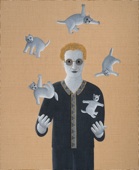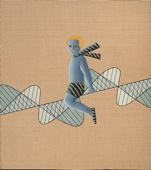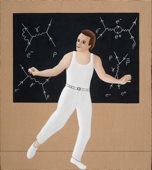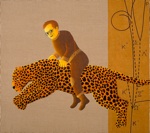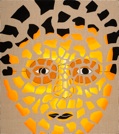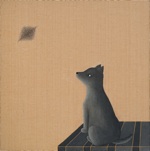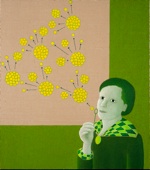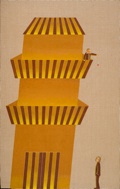Painted Physics

The physicists portrayed in Painted Physics experienced a time of deep insight and creativity. They envisioned and described the world in a new way and changed our understanding of time and space. They predicted physical events no one ever imagined. Much of what they found does not conform to our everyday experience. Their discoveries profoundly altered important aspects of culture, philosophical thought, religion, ethics and art.
Creativity and the desire to penetrate the mysterious connect art and physics. We stand in awe of great science and great art because they create a sense of wonder; both ask as many questions as they answer. Science and art make us curious about the obvious, connecting us emotionally and aesthetically to something more universal than our own lives.
The appreciation of truth and beauty is another link between art and physics. Werner Heisenberg said, "Beauty is the proper conformity of the parts to one another and to the whole." Herman Weyl wrote about his work in physics, "My work always tried to unite the true with the beautiful; but when I had to choose one or the other I usually chose the beautiful." Truth and beauty are difficult to define, but they exist equally in art and physics.
A thought experiment is an imaginary, mental construct devised to test a hypothesis or theory. Although it may not actually be constructed and performed in the real world, it can be a vivid and detailed visualization. Einstein used thought experiments to formulate many of his scientific ideas. Schrödinger’s Cat is an example of a thought experiment that looks like a stage set, as is Galileo’s thought experiment about the laws of physics and relative motion. Placed in an aesthetic context, thought experiments are profound, conceptual art installations and the scientists creating them can be viewed as artists making work of deep intellectual and artistic value.
A major difference between art and physics is the necessity for a scientific theory to be capable of being falsified. Art can exist in a completely metaphorical or metaphysical realm, but science is tied to conformation in the physical world. To be accepted, a scientific theory must, at least in principle, be falsifiable. Art can be a success or a failure but it can never be proven false in a scientific sense.
One of Albert Einstein’s guiding principles was “Everything should be made as simple as possible, but not simpler.” Each brush stroke of every painting in this series was made with that thought in mind. The paintings are an attempt to capture the truth and beauty of the creative moment.
Painted Physics would not exist in its present form without the contributions of Bob Eisenstein, who generously and abundantly shared his knowledge of science, his insights about physics and his editorial comments.
Orlando Leibovitz
Santa Fe, New Mexico
December 2009
